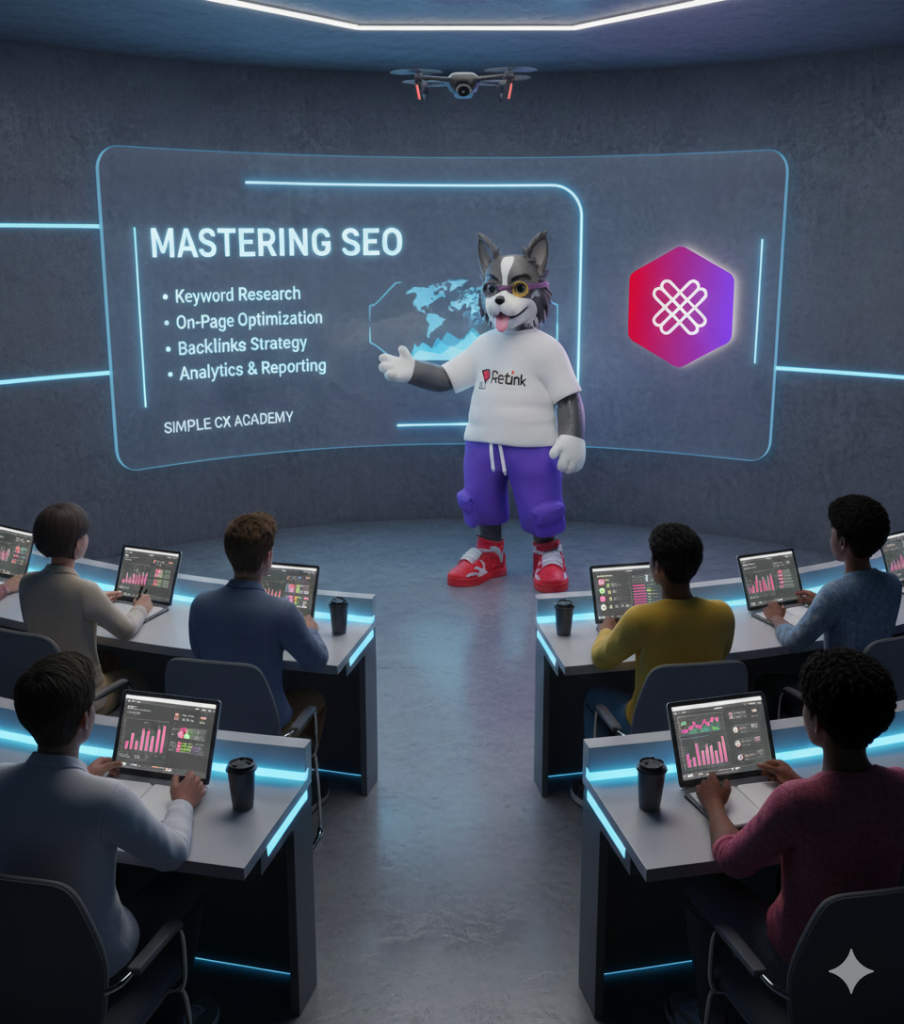Host: Hello, lovely people, and welcome back to another episode of “Talk AI with rai Show: The Pulse of the AI Revolution.”
Thank you so much for tuning in!
I can already see Mervy on Facebook, welcome, Josh! and Max, tuning in from LinkedIn Live.

It’s always such a joy to have you with us.
Now, warm up your seats because rai is itching with excitement for today’s topic.
Last week, we discovered how AI has quietly infiltrated almost every business. And wow, your responses were overwhelming!
Here’s the link for those who missed that episode
We got to learn that you don’t just fall for the AI hype. No. Instead, you first identify the problem and then use AI to solve that specific problem. How cool !!
And today, we’re taking that journey a step further.
We want to find out how SEO, when paired with AI, can be a real game-changer. Does SEO boost leads and clicks, especially for marketers?
Trust me, after today’s episode, your blogs will rock.
So, let’s get to it.
Host: [turning to rai] Hello rai, you’re awfully quiet today.
rai: Hahaha! My mic was off.
Both: [laughs together]
rai: I’ve actually been waiting for my turn. Woof!
Thanks for having me! This is a topic I’m really excited about. AI has completely transformed the way we think about blogging and SEO.
Introducing SEO.
Host: Absolutely. And what is SEO anyway? Recently, I read that it’s no longer just about a well-polished write-up for Google- psst!
Nowadays, Google uses a bunch of metrics to analyse what to rank. What is this all about, rai?
rai: Well. You’re totally right. The game has shifted.
Firstly, SEO, or Search Engine Optimization, is the practice of making your content easier for both people and Google to find and trust.
rai: It is more like putting a bright, clear sign outside your shop. This helps visitors to locate you and get straight through your door.
Host: Hahaha! That’s a funny way of putting it.
rai: Woof! So, Google looks at a bunch of things and decides who ranks where. That is why throwing in keywords does not work anymore.

Let me walk you through them.
- First, we have search intent: Google tries to figure out what the user really wants. Are they looking for instructions, a quick fact, or maybe to buy something? If your blog matches that intent, then you’re already in a good spot.
- Then comes quality and expertise: Google does not want guesswork. It wants to know if you’re a trustworthy source who knows what they are talking about. If so, then you’ll enjoy a top ranking.
- Next up is user experience. This one is huge.
Host: Mmm! Does it involve frustrations when conducting a search?
rai: Well, somehow. But, it is more of if your page loads slowly or things keep shifting around while it loads. This outrightly makes people get frustrated.
Google is super keen on speed, stability, and responsiveness.
Host: Ohh, yeah!! Speed is such a big factor if one wants to enjoy the rankings.
- After that, it’s about usability: Once again, Google quickly takes notes of pages that feel messy. So if your buttons don’t click easily, or the content is unreadable on the phone, Google points it out.
- We also can’t forget user engagement. Do people scroll, stay, or read when they land on your page? Or do they up and leave? Google takes an interest in such, beyond the clicks.
Those behaviors tell Google if your blog is actually helpful and subsequently rankable.
- And finally, backlinks: This is when respected sites link back to your blog. Google considers it a sign of credible content worth ranking higher.
Host: Wow, that’s a lot more than I expected. It almost feels like we’ve already covered a whole episode just talking about SEO on its own.
Rai: True. SEO has now become the most important ingredient when drafting up your blog. It’s a must-have if you want to drive traffic to your page
Again, with AI in place, the generation of blogs has become a simple and quick exercise. However, if you just let AI write without guidance, you’ll end up with something generic.
But if you use it as a tool and add human expertise, you can absolutely create SEO-friendly blogs that rank.
Host: I am getting confused here. AI can write polished blogs just like professional editors. Then how come it is not the magic bullet as perceived?
rai: That’s a simple one. AI tools only give you a general analogy. In fact, HubSpot emphasises that blogging success comes from understanding your audience, solving their problems, and providing value.
AI cannot solve this unless you bring in your real expertise, credibility, and trustworthiness.
Host: That makes sense now.
But let’s circle back to today’s main topic, how to actually use AI to create SEO-friendly blog posts.
And I can see our listeners are keeping up fast. Josh has already kicked things off by pointing out keywords as the number one factor.
Why Strategic Keywords Are Essential to Boost Your SEO
So, rai, let’s unbox keywords a bit.
rai: Sure. Josh is absolutely right. Researching for the right keywords is critical to know what the audience is concentrating on.
Luckily, AI tools such as SurferSEO or SEMrush provide this with ease.
They analyse thousands of search queries and give you the right keywords, search volume, and even related terms.
Surfer’s blog, for example, suggests asking yourself key questions like: Who am I writing for? What is their search intent? And what keywords should I focus on?
Once you have these answers, you can feed those keywords into your AI writing tool and guide the output.
Host: So instead of stuffing keywords everywhere, it’s about placing them naturally?
rai: Yes. Remember, we already established that Google concentrates on the search intent of the users as a factor for ranking.
So, you want to use the right keywords that users are typing.. Google rewards content that reads naturally and satisfies intent.
How a Strong Blog Structure Enhances Both SEO and User Experience
Next up is the blog structure.
Host: Is this about organising content?
rai: Yes. You’re right. The blog structure is about the use of headings and subheadings. Readers enjoy skimming through segmented write-ups.
It also helps Google to understand your content.
An SEO-friendly blog needs H2’s, H3’s, short paragraphs, and bullet points.
AI tools can generate outlines instantly, but you should still refine them and give them a flow.
Platforms like simplecx can also assist here by turning a single idea into a structured outline across blog, video, and social media formats.
This saves marketers up to 40 hours per month in time for their content creation strategy.

Why Humanizing AI Content Matters for Readers and SEO
Host: But rai, I have seen AI-generated content that is perfect to the last dot. It flows seamlessly and perfectly.
Don’t we all want an easy way out?
rai: True. You will, however, notice that it lacks the human touch. It will sound too robotic and pitch-perfect.
And I think this is where most people are struggling..
They let AI write and immediately hit the publish button, even without a second look.
Instead, writers should look to edit for tone and authenticity. Make your blog sound like your brand.
In addition, fact-check for accuracy and make the blog conversational.
A practical example is this podcast blog. If you take this conversation and feed it into AI, you’ll get blogs that feel human.
Host: So basically, AI helps with speed, but humans bring the soul.
rai: Hahaha! Exactly! And think about it, without a soul, a human body is just… well, a shell.
The same goes for blogs. AI can give you structure and words, but it’s the human touch that breathes life into the content and makes it feel alive to the reader.
Both: Hahaha!
On-Page SEO Essentials for AI Content
Host: Let’s get technical for a moment. What about on-page SEO?
rai: Ohh, thanks! It almost escaped my mind. On-page SEO simply means all the things you do directly on your blog page to help it rank better in search results.
Once your draft is ready, you’ll want to make sure your meta title and description include your keyword.
Also, add internal links to other blogs on your site, as well as references to external, credible links
Don’t forget about images, give them proper alt text so they’re search-friendly.
And of course, keep your blog mobile-friendly with short, easy-to-scan paragraphs.
Tools like simplecx even provide intelligent optimisation support, showing whether your blog has the right keyword density, headings, and structure.
This, you’ll realise it comes in handy when fine-tuning the blog.
When you have done all of the above, repurpose your content. Keep updating old blogs with new statistics, keywords, and formatting.
Luckily, simplecx, our soon-to-launch multimodal AI tool, can repurpose a blog into social posts, newsletters, or even podcast transcripts like this one from one dashboard.
With simplecx, you’re guaranteed of:

- A creativity score before you publish
- Smart tips from rai + strategicx to boost originality
- Confidence that your content will catch eyes and spark engagement
Host: Oh, full circle moment! Wow! But, I just heard you mention strategicx? Do you guys work together?
rai: Haha! Silly me. I should have mentioned it. Strategicx is the AI engine that processes and analyses your inputs, providing technical recommendations.
Then I come in as the user-facing part that translates those technical insights into a conversational and easy-to-understand format.
Because at simplecx, we believe great content isn’t just made, it’s measured, improved, and then launched with confidence.
This helps you strategise and map out your entire content calendar, allowing you to plan with confidence.
Host: {Nods in agreement} rai, if you had to give one takeaway for listeners trying to use AI for SEO blogging, what would it be?
rai: I’d say, use AI to speed up research, drafts, and optimisation, but always inject your expertise, brand voice, and storytelling.
That’s what makes your blog stand out from the 1,000 AI-written posts out there.
Host: Love that.The perfect summary.
Before we wrap, let’s hit some rapid-fire FAQs. Ready?
rai: Let’s do it.
Q1. Can AI-written blogs rank on Google?
Yes, if they’re optimised for search intent, structured well, and edited for accuracy and engagement.
Q2. What AI tools are best for SEO blogging?
SurferSEO, Jasper, ChatGPT, and HubSpot’s AI features are popular choices.
But don’t be left out when simplecx launches. It’s set to change how digital marketing, content creation, and social media marketing come together.
![]()
Hahaha! We are here waiting eagerly!
Q3. How long should an SEO-friendly blog be?
Ideally, 1,500–2,500 words, depending on the keyword competition.

Q4. Should I publish AI-written content without editing?
No. Always review for accuracy, brand tone, and originality.
Q5. How often should I update my blogs?
At least every 6–12 months, or sooner if your topic changes quickly.
Q6. Does Google penalise AI content?
Not if it’s high quality. Google cares about value and helpfulness, not whether a human or AI wrote it.
Host: And that’s a wrap on today’s episode! Today we have seen how AI can transform blogging if you use it wisely. From keyword research and structure to on-page SEO and updates, the key is balance.
But don’t just settle in yet. SEO is evolving. Have you heard of Generative Engine Optimization (GEO)? The art of making your content more visible and useful to AI systems, not just traditional search engines?
Worry not. Because, you, our listeners, just got lucky. This is what we shall be tackling in our next episode.
Stay tuned as we dive into this exciting new frontier in digital marketing.
Thanks, rai, and thanks to our listeners.
rai: Woof! Woof! Keep learning.
To stay updated with our latest insights and exclusive content, please consider filling out this form ” –https://simplecx.retink.io/form
